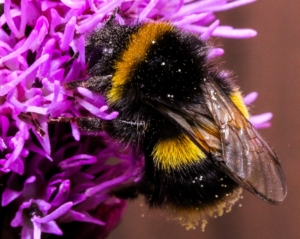Five Ways You Can Help Bumblebees
Save the Bees
by Sam Doll
When you hear “Save the Bees!” what is the first thing you think of? For most people, the first image that comes to mind are large colonies of hard-working honeybees buzzing to and fro in service of their queen. This fantasy might even include a beekeeper lovingly tending to their many hives. While the honeybee is a vital part of our food system, pollinating many of our crops and providing us with beeswax and honey, they are not the only bee we need to be worried about!
There are nearly 4,000 species of native bees in the United States alone! Native bees Honeybees were brought to North America by European settlers and are not actually endemic to the US. These native bees come in an astonishing variety of shapes, sizes, and colors. In this blog, we will talk about one group of native bee and what you can do to help them: the bumblebee!

Bumblebees are one of the most recognizable types of bees, right behind the honeybee, notable due to their large, fuzzy appearance. There are 46 species of bumblebee in North America. Bumblebees are also unique for being some of the only social native bees, forming small underground colonies with a queen and worker system. However, unlike honeybees, the colony does not overwinter but creates new “queens” that will emerge and create their own colonies the next spring.
Bumblebees are especially important because they can perform buzz pollination. Some plants’ pollen is more firmly attached to their anthers and needs a little help being shaken loose. The bumblebee, along with a few other native bees, can “buzz” by dethatching their wings from their flying muscles and vibrating. This releases the sticky pollen and gives the bee and the flower what it needs! Tomatoes, eggplant, and blueberries are all buzz pollinated species!
Tips for protecting Bumblebees
- Plant native flowers and bumblebee friendly vegetables. We recommend our Bee Rescue Wildflower Mix or any of our heirloom tomatoes in the veggie section of our store!
- Leave the more unused parts of your land unused. Bumblebees nest in old animal burrows and new queens will overwinter in tiny holes in the ground.
- Avoid raking, tilling or mowing your yard until April or May to protect overwintering bees
- Eliminate pesticide use in your yard. Try more natural pest management techniques. Check out our blog about natural weed and pest control.
- Report the bees you see to Bumble Bee Watch, a new citizen-science project sponsored by the Xerces Society and five North American partners.
For more garden tips, pollinator facts, and great deals, make sure to follow our newsletter!


Leave a Reply
Want to join the discussion?Feel free to contribute!